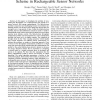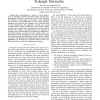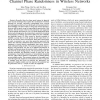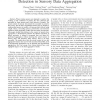INFOCOM
2011
IEEE
13 years 3 months ago
2011
IEEE
—For energy conservation, a wireless sensor network is usually designed to work in a low-duty-cycle mode, in which a sensor node keeps active for a small percentage of time durin...
INFOCOM
2011
IEEE
13 years 3 months ago
2011
IEEE
—Body sensor networks (BSNs) have been developed for a set of performance-critical applications, including smart healthcare, assisted living, emergency response, athletic perform...
INFOCOM
2011
IEEE
13 years 3 months ago
2011
IEEE
—This paper considers the problem of designing scheduling algorithms for multi-channel (e.g., OFDM-based) wireless downlink systems. We show that the Server-Side Greedy (SSG) rul...
INFOCOM
2011
IEEE
13 years 3 months ago
2011
IEEE
—Dynamic spectrum allocation has proven promising for mitigating the spectrum scarcity problem. In this model, primary users lease chunks of under-utilized spectrum to secondary ...
INFOCOM
2011
IEEE
13 years 3 months ago
2011
IEEE
Abstract—In this paper, we investigate the problem of maximizing the throughput over a finite-horizon time period for a sensor network with energy replenishment. The finite-horiz...
INFOCOM
2011
IEEE
13 years 3 months ago
2011
IEEE
Abstract—We study the ubiquitous data collection for mobile users in wireless sensor networks. People with handheld devices can easily interact with the network and collect data....
INFOCOM
2011
IEEE
13 years 3 months ago
2011
IEEE
Abstract—Data dissemination is useful for many applications of Disruption Tolerant Networks (DTNs). Current data dissemination schemes are generally network-centric ignoring user...
INFOCOM
2011
IEEE
13 years 3 months ago
2011
IEEE
—Recently, there has been great interest in physical layer security techniques that exploit the randomness of wireless channels for securely extracting cryptographic keys. Severa...
INFOCOM
2011
IEEE
13 years 3 months ago
2011
IEEE
Abstract—Due to the emergence of Cognitive Radio, a special type of heterogeneous networks attracts increasing interest recently, in which a secondary network composed of cogniti...
INFOCOM
2011
IEEE
13 years 3 months ago
2011
IEEE
—When wireless sensors are deployed to monitor the working or life conditions of people, the data collected and processed by these sensors may reveal privacy of people. The actua...




